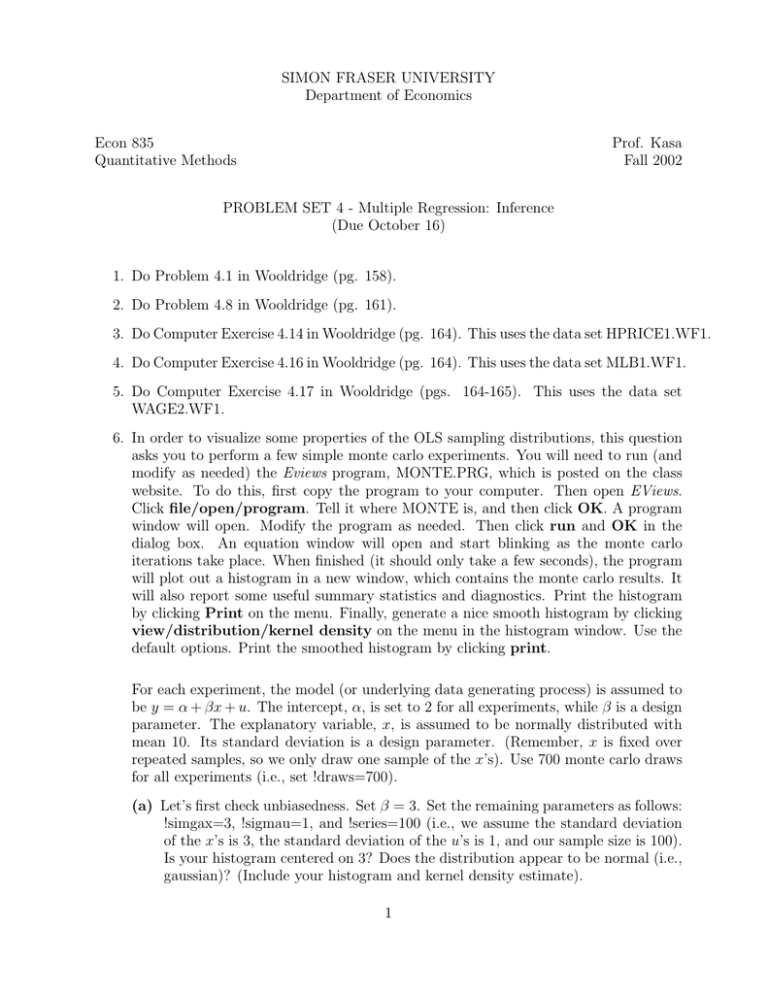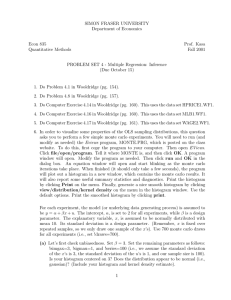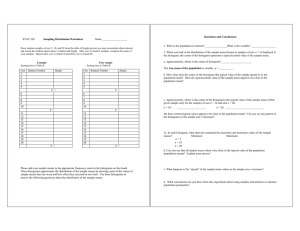SIMON FRASER UNIVERSITY Department of Economics Econ 835 Prof. Kasa
advertisement

SIMON FRASER UNIVERSITY Department of Economics Econ 835 Quantitative Methods Prof. Kasa Fall 2002 PROBLEM SET 4 - Multiple Regression: Inference (Due October 16) 1. Do Problem 4.1 in Wooldridge (pg. 158). 2. Do Problem 4.8 in Wooldridge (pg. 161). 3. Do Computer Exercise 4.14 in Wooldridge (pg. 164). This uses the data set HPRICE1.WF1. 4. Do Computer Exercise 4.16 in Wooldridge (pg. 164). This uses the data set MLB1.WF1. 5. Do Computer Exercise 4.17 in Wooldridge (pgs. 164-165). This uses the data set WAGE2.WF1. 6. In order to visualize some properties of the OLS sampling distributions, this question asks you to perform a few simple monte carlo experiments. You will need to run (and modify as needed) the Eviews program, MONTE.PRG, which is posted on the class website. To do this, first copy the program to your computer. Then open EViews. Click file/open/program. Tell it where MONTE is, and then click OK. A program window will open. Modify the program as needed. Then click run and OK in the dialog box. An equation window will open and start blinking as the monte carlo iterations take place. When finished (it should only take a few seconds), the program will plot out a histogram in a new window, which contains the monte carlo results. It will also report some useful summary statistics and diagnostics. Print the histogram by clicking Print on the menu. Finally, generate a nice smooth histogram by clicking view/distribution/kernel density on the menu in the histogram window. Use the default options. Print the smoothed histogram by clicking print. For each experiment, the model (or underlying data generating process) is assumed to be y = α + βx + u. The intercept, α, is set to 2 for all experiments, while β is a design parameter. The explanatory variable, x, is assumed to be normally distributed with mean 10. Its standard deviation is a design parameter. (Remember, x is fixed over repeated samples, so we only draw one sample of the x’s). Use 700 monte carlo draws for all experiments (i.e., set !draws=700). (a) Let’s first check unbiasedness. Set β = 3. Set the remaining parameters as follows: !simgax=3, !sigmau=1, and !series=100 (i.e., we assume the standard deviation of the x’s is 3, the standard deviation of the u’s is 1, and our sample size is 100). Is your histogram centered on 3? Does the distribution appear to be normal (i.e., gaussian)? (Include your histogram and kernel density estimate). 1 (b) Now let’s see what happens as the error variance changes. Set β = 3 and again set !sigmax=3 and !series=100. Do two separate monte carlos, one with !sigmau=1, and one with !sigmau=2. Are the relative variances of the β̂ histograms consistent with the theory in chapter 2? (Include your histograms and kernel density estimates). (c) Now let’s see what happens as the sample variance of the x’s changes. Set β = 3 and !sigmau=1 and !series=100. Do two separate monte carlos, one with !sigmax=3, and one with !sigmax=6. Are the relative variances of the β̂ histograms consistent with the theory in chapter 2? (Include your histograms and kernel density estimates). (d) Now let’s check out the asymptotic predictions in chapter 5. First let’s see what happens as the sample size changes. Set β = 3, !sigmax=3, and !sigmau=1. Do two separate monte carlos, one with !series=20, and one with !series=500. Is the sampling distribution of β̂ converging to a probability limit? What is it? Are the relative variances of the β̂ histograms consistent with the theory in chapter 5? (Include your histograms and kernel density estimates). (e) Finally, let’s verify that the large sample distribution of β̂ is normal, regardless of the error distribution. Set β = 3, !sigmax=3, !series=300. Now, however, change the line in the loop where we take draws on u. Instead of the normal distribution, let’s assume the u’s come from a uniform distribution on the interval [−2, 2]. To do this, just change “!sigmau*nrnd” to “@runif(-2,2)”. Do you still get a nice bellshaped β̂ distribution? If so, congratulations!, you have just verified the central limit theorem. (Include your histogram). 2



